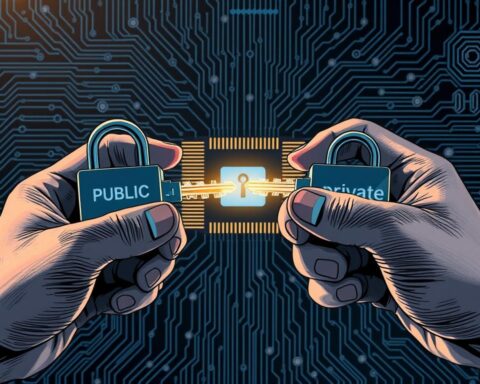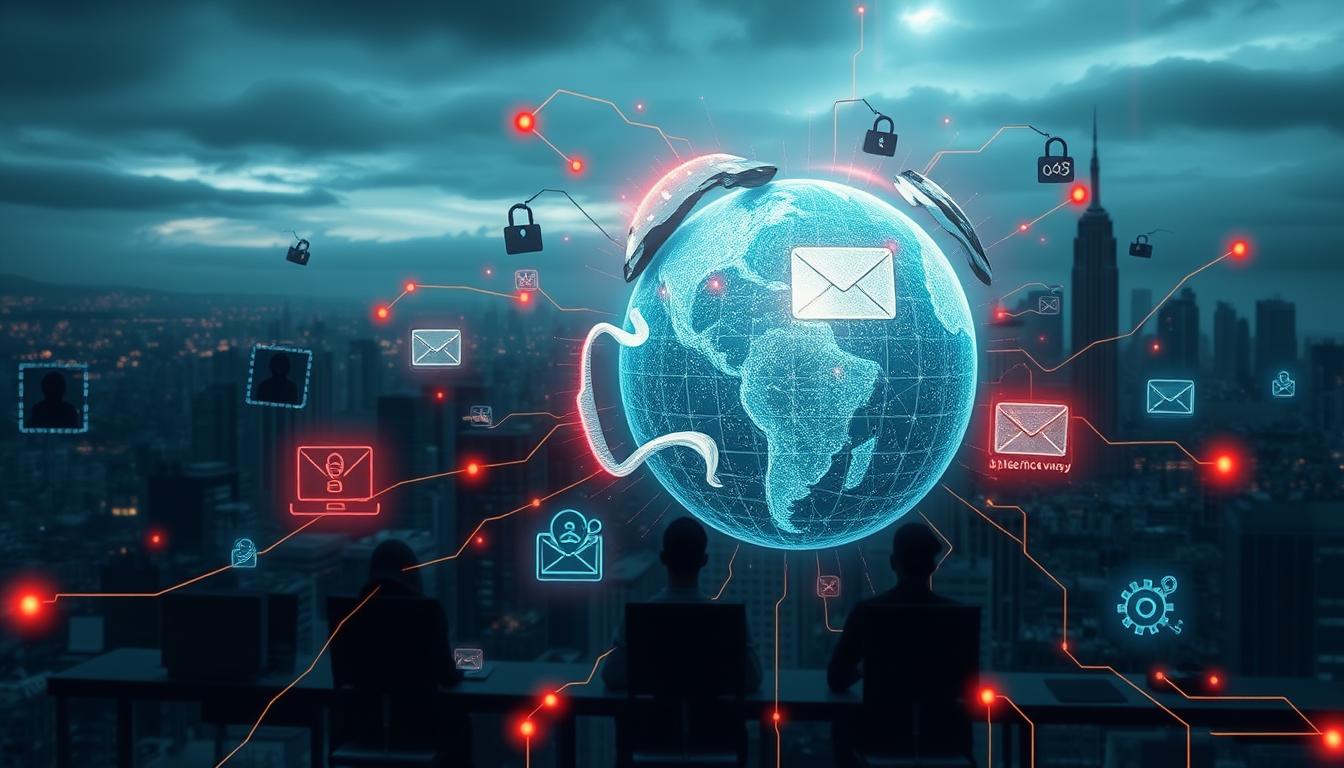Did you know 89% of organizations see effective incident response as key to fighting cyber threats1? This fact highlights the importance of our 31-day cybersecurity training. As we finish this program, it’s clear that digital security is changing fast. We must stay alert and adapt quickly.
In this month-long journey, we’ve delved into the complex world of cybersecurity. We’ve learned about software vulnerabilities and how to handle incidents. Our next steps are vital for keeping up in this digital battle.
Our training has made a big difference. Companies with good incident response plans can cut down on response time by half1. But, our work is far from over. Cyber threats are always changing, and so must we.
Looking to the future, we need to keep learning and adapting. The cybersecurity world of tomorrow will ask even more of us. By building on what we’ve learned, we can create a strong and lasting cybersecurity future. This future will protect our digital world and our country’s interests.
Key Takeaways
- Effective incident response is key for 89% of organizations
- Good response plans can cut down response time by half
- Continuous learning is vital in the changing threat landscape
- Creating a lasting cybersecurity future needs ongoing effort
- Our 31-day training lays a strong foundation for growth
- Adaptation and vigilance are essential to outsmart cyber threats
Understanding the Current Cybersecurity Landscape
The world of cybersecurity is changing fast. Digital changes and new threats are making it harder for companies to keep their data safe. They must fight off smarter cyber attacks.
Impact of Digital Transformation
Digital changes have made businesses better but also more vulnerable. With complex systems and networks, there are more ways for hackers to get in. Companies need strong plans to protect themselves2.
Evolving Threat Vectors
Cyber threats are always getting smarter. Ransomware is a big problem, with new, tricky versions popping up. It’s also getting harder to spot fake messages and emails23.
Key Industry Challenges
In 2024, cybersecurity pros will face big challenges:
- Stopping bad uses of big language models
- Keeping up with new ransomware tricks
- Protecting complex supply chains
- Dealing with spyware on the market
Companies need to be quick to react and use smart security plans. This is the only way to keep their systems and data safe23.
| Challenge | Impact | Mitigation Strategy |
|---|---|---|
| Malicious LLMs | Misinformation, fake news, cyberattacks | AI-powered threat detection |
| Evolving Ransomware | Financial losses, data breaches | Regular backups, employee training |
| Complex Supply Chains | Large-scale compromises | Vendor risk management |
| Commercial Spyware | Privacy violations, data theft | Enhanced endpoint protection |
As cybersecurity keeps changing, companies must stay ahead of threats. They need to be proactive in defending themselves. This is key to keeping their digital world safe4.
Final Recap and Next Steps: Building a Sustainable Cybersecurity Future
The world of cybersecurity is changing fast. President Biden’s Executive Order on Strengthening Cybersecurity, issued on January 16, 2025, shows how urgent it is to protect our digital world5. This order builds on previous steps, focusing on better managing third-party risks and making software safer5.
To create a lasting cybersecurity future, we need new strategies. Using AI has shown great results, with companies seeing an average return of $10.3 for every dollar spent in 20246. AI has also made it possible to respond to cyber threats much faster, reducing damage6.
Zero Trust architecture is becoming key in keeping digital assets safe. It’s a top strategy as cyber threats are at an all-time high6. The executive order on advancing AI infrastructure also highlights AI’s role in national security and economic growth.
Prioritizing Skills Development
As we look ahead, we must tackle the growing need for skills in AI, cloud computing, and cybersecurity. Companies are boosting their training programs and teaming up with tech providers to improve AI skills and security knowledge6. This focus on training is vital for a workforce ready to face future cybersecurity challenges.
| Cybersecurity Focus Area | Key Initiative | Impact |
|---|---|---|
| AI Integration | Microsoft Copilot Adoption | 30% increase in operational efficiency6 |
| Incident Response | AI-Driven Solutions | Response time reduced to minutes6 |
| Compliance | NIST Framework Prioritization | Enhanced data protection and trust6 |
To build a lasting cybersecurity future, we need a mix of strategies. Using AI, implementing Zero Trust, and training our workforce are key steps. The path to a secure digital world is long, but with careful planning and constant improvement, we can make it safer for everyone.
Essential Components of Modern Cybersecurity Framework
A strong cybersecurity framework is key in today’s digital world. With spending on cybersecurity set to hit over $1.75 trillion by 2025, companies know they need to protect themselves well7. Let’s look at the main parts of a good cybersecurity plan.
Risk Assessment Methodologies
Risk assessment is the base of a good cybersecurity plan. It finds, analyzes, and sorts threats to digital assets. The NIST Cybersecurity Framework, downloaded over 1.7 million times, gives a clear way to do this8.
This framework helps all kinds of businesses check their cybersecurity and find ways to lower risks.
Security Controls Implementation
Putting in place strong security controls is key to fighting cyber threats. These controls can be technical or non-technical. Companies using AI in security have seen a $2.2 million drop in breach costs7.
Incident Response Protocols
Good incident response is vital to limit damage from cyber attacks. With data breach costs hitting $4.88 million in 2023, having a solid plan is more critical than ever7. This means having steps for spotting, handling, and fixing security issues.
| Component | Key Benefits | Challenges |
|---|---|---|
| Risk Assessment | Prioritizes threats, guides resource allocation | Requires ongoing updates, expertise |
| Security Controls | Prevents breaches, reduces attack surface | Can be costly, needs regular maintenance |
| Incident Response | Minimizes breach impact, speeds recovery | Demands rapid action, continuous training |
By combining these key parts, companies can build a strong defense against cyber threats. The NIST Cybersecurity Framework, with its seven themes and 25 subthemes, offers a detailed guide for these important steps8.
Strategic Planning for Cyber Resilience

In today’s digital world, cyber resilience is key for a strong cybersecurity future. Companies need solid plans to face, handle, and bounce back from cyber attacks. Those with good data loss prevention policies see a 35% drop in breaches9.
Good risk management begins with a detailed check-up. Firms that regularly assess risks and update their security see a 30% better security stance9. This matches the 2023 Federal Cybersecurity Research and Development Strategic Plan’s focus on changing cybersecurity needs10.
Key parts of cyber resilience planning include:
- Business continuity planning
- Disaster recovery strategies
- Integration of resilience into overall business strategy
Companies that invest in quick detection and response cut their response times by 50%. This helps limit damage9. It also fits with the federal goal of boosting cyber resilience and trust in systems10.
Being ready for responses boosts resilience. Stats show firms with strong Business Continuity Plans are 60% more likely to bounce back from cyber attacks9. This shows how vital it is to link cybersecurity with business goals for lasting success.
“Cyber resilience is not just about defense; it’s about building an organization that can thrive in the face of digital adversity.”
By focusing on these key areas and always improving their cybersecurity plans, companies can create a strong, resilient base. This base can handle the changing threat landscape.
Implementing Effective Security Awareness Programs
In today’s digital world, security awareness is key to protecting organizations from cyber threats. With 82% of security breaches caused by human error, it’s vital to have good training11.
Employee Training Initiatives
Companies are using new ways to teach staff about cybersecurity risks. Google and JPMorgan Chase have big training programs. They cover everything from password safety to spotting phishing scams11. Google even uses games to make learning fun.
Compliance Requirements
Security awareness programs also help meet legal standards. The US Department of Defense is a great example. They use online courses and fake cyberattacks to train employees11. This keeps staff up-to-date on new threats and how to avoid them.
Measuring Program Success
It’s important to check if security awareness programs work. Tests before and after training can show if people know more about cyber threats12. Studies show that using simulations is the best way to teach security awareness12.
| Delivery Method | Effectiveness Ranking |
|---|---|
| Simulation-based | 1 |
| Instructor-led | 2 |
| Intranet | 3 |
By using these methods, companies can build a culture of security awareness. This helps lower the chance of data breaches. Regular training and checks are essential to keep strong against new threats.
Advanced Threat Detection and Response
The threat landscape is changing fast, and so are cyber attacks. Companies need to get better at handling these attacks. The cost of cyber attacks could hit USD 10.5 trillion by 2025, showing how urgent it is to have strong security13.
New ways to find threats are being used. These include using artificial intelligence and machine learning. Systems like SIEM help by looking at lots of data to find odd patterns.
Looking for threats before they happen is key now. This means searching for hidden dangers in networks. Companies are also moving to a “zero trust” model, where no one is trusted by default. Microsoft’s Security Foundations Initiative is a good example, making sure all apps are safe and users are protected from phishing14.
Having a good plan for when attacks happen is important. The U.S. is spending $65 billion to help keep critical areas safe. This shows how important it is for companies and governments to work together to keep the internet safe.
| Key Component | Description | Impact |
|---|---|---|
| AI-powered Detection | Uses machine learning to identify anomalies | Faster threat identification |
| Threat Intelligence | Aggregates data from various sources | Improved context for threats |
| Automated Response | Initiates predefined actions upon threat detection | Reduced response time |
Companies need to keep learning and updating their security plans. With the digital market set to hit USD 2.1 trillion by 2023, investing in top-notch security is a must13.
Building Cybersecurity Culture and Competence
In today’s digital world, having a strong cybersecurity culture is key. Cybercrime damages are expected to hit $6 trillion by 202115. This section looks at how to create a security-focused environment.
Leadership Engagement
Support from top management is essential for building a cybersecurity culture16. Leaders must make security awareness a priority. By 2025, cybercrime costs could reach $10.5 trillion, showing the need for strong leadership17.
Team Development
Training employees is critical. Human mistakes cause 95% of cybersecurity breaches15. It’s important to have a well-trained team. Companies should offer thorough security training and encourage teamwork.
Performance Metrics
It’s important to measure cybersecurity skills. While surveys are used, they might not fully capture the culture16. Companies should create detailed metrics that cover both technical and behavioral aspects of cybersecurity.
| Metric | Description | Importance |
|---|---|---|
| Security Incident Rate | Number of security incidents per month | High |
| Employee Training Completion | Percentage of staff completing security training | Medium |
| Phishing Test Success Rate | Percentage of employees who identify phishing attempts | High |
By focusing on these areas, organizations can create a strong cybersecurity culture. This empowers all employees to help protect the company’s digital security.
Technology Integration and Innovation
The world of cybersecurity is changing fast. New technologies are changing how we keep our digital world safe. Cloud and edge computing are key, with 84% of financial-services companies seeing their value18. Now, 60% of companies have more than a quarter of their work in the cloud18.
Secure software development is leading the way in innovation. Almost 75% of businesses see the value in next-gen software development. But, only 11% have fully adopted these new methods18. This shows we need to move faster in using the latest cybersecurity practices.
Artificial Intelligence (AI) is making big moves in cybersecurity. Almost 80% of companies see AI’s importance, but 70% are just starting to use it18. This creates both chances and challenges in making secure AI systems.
The United States’ International Cyberspace and Digital Policy aims to build a strong digital world. It wants to promote an open, secure, and resilient digital ecosystem. This goal matches the global push for better cybersecurity, like the Oceania Cyber Security Centre (OCSC)19.
Trust architecture is becoming more important, with 70% of companies seeing its value18. This focus on trust is key, as 84% of organizations faced identity-related breaches last year18. Combining new technologies with strong security is essential for a safe digital future.
| Technology | Recognition | Full Adoption |
|---|---|---|
| Cloud and Edge Computing | 84% | 42% |
| Applied AI | 80% | 30% |
| Next-gen Software Development | 75% | 11% |
| Trust Architecture | 70% | N/A |
Regulatory Compliance and Standards
The world of cybersecurity is changing fast. Keeping up with rules and protecting privacy is now key for businesses. They must meet industry standards and get ready for tough audits.
Industry Requirements
Each sector has its own cybersecurity rules. Banks must follow strict data rules, while hospitals protect patient data. The energy sector must protect critical infrastructure. Companies face new AI rules that could raise costs and risks20.
Global Standards
Frameworks like NIST, ISO 27001, and GDPR set global cybersecurity standards. Companies must keep up to stay trusted and avoid fines. The EU’s Corporate Sustainability Reporting Directive may require detailed reports for big companies20.
Audit Preparation
Getting ready for audits is vital to show you follow the rules. Companies should:
- Keep records of security policies and steps
- Do regular risk checks
- Use strong access controls
- Train staff on security tips
Only 2% of leaders say their company is fully ready for cyber resilience. This shows a big need for improvement21. Companies should see compliance as a chance to boost their cybersecurity, not just follow rules.
| Compliance Area | Executive Confidence | Preparedness Level |
|---|---|---|
| AI Regulations | Low | Moderate |
| Critical Infrastructure | Moderate | Low |
| Data Privacy | High | High |
| Cyber Resilience | Low | Low |
As rules keep changing, companies must stay alert. Using generative AI opens new chances but also increases cyber risks21. Businesses should invest in better response plans and keep up with new threats to stay compliant and protect privacy.
Future-Proofing Security Infrastructure
Cyber threats are changing fast, and so must our security. Companies need to keep up with new threats in the digital world. They should use strong cybersecurity plans and new tech to make their systems strong.
Zero Trust architecture is becoming more popular for security. By 2025, 60% of companies will switch from old VPNs to Zero-Trust solutions22. This method doesn’t trust anyone by default and checks everyone and everything all the time.
Cybercrime costs are going up fast. By 2025, it’s expected to hit $10.5 trillion a year, up from $3 trillion a decade ago22. This shows how important it is to have strong security and keep updating it.
Microsoft’s Secure Future Initiative (SFI) is a big effort in cybersecurity. It has the support of 34,000 full-time engineers, making it the biggest cybersecurity project ever23. This shows how much companies now see cybersecurity as key to their success.
Using Privacy-Enhancing Technologies (PETs) is getting more important because of laws. About 70% of countries have laws about data privacy now22. Keeping data safe is a big part of security now.
AI is becoming a big help in fighting cyber threats. Old ways of finding threats can’t keep up with new ones. AI can look at lots of data fast and find threats before they happen.
To keep security strong for the future, we need to do many things. We should use zero trust, AI, PETs, and stay ready for new threats. By doing these things, companies can make their security better and more ready for the future.
Conclusion
As we finish our 31-day cybersecurity training, it’s clear we need to stay alert and keep learning. The world of cybersecurity is changing fast. It’s expected to grow from $120 billion to $300 billion by 202424. This shows how important it is to protect ourselves online.
We’ve learned important steps to build a strong security culture. We’ve talked about doing thorough risk assessments and using the latest threat detection tools. It’s now understood that we should always be ready for cyber attacks, not just worry about them happening24.
Looking to the future, we need to keep learning and getting better. Make sure your team gets regular security training. This helps them remember important security rules25. Also, think about setting up a way for people to report security issues anonymously25.
By staying up-to-date, flexible, and working together, we can face the challenges of cybersecurity. We can make the digital world safer for everyone.
FAQ
What are the key components of a modern cybersecurity framework?
A modern cybersecurity framework includes several key parts. These are risk assessment, security controls, and incident response. Together, they help spot threats, protect against them, and handle security incidents well.
How can organizations build a strong cybersecurity culture?
To build a strong cybersecurity culture, organizations need to engage leaders and develop teams. They should also set clear performance goals. This means spreading security awareness, training employees, and working together across departments. Regularly checking and improving cybersecurity skills is also important.
What role do emerging technologies play in cybersecurity?
Emerging tech like AI, machine learning, blockchain, and IoT are changing cybersecurity. They help detect and respond to threats better but also bring new challenges. It’s important for organizations to use these technologies securely and focus on security while innovating.
How can companies ensure regulatory compliance in cybersecurity?
Companies can follow industry rules and global standards like NIST and GDPR to ensure compliance. Regular audits are key. Compliance should be seen as a chance to improve security and gain trust from stakeholders, not just a task to complete.
What strategies can be used to future-proof security infrastructure?
To future-proof security, consider adaptive security, zero trust, and cloud computing. Also, prepare for quantum computing’s impact. Keeping security systems updated and tested is vital to stay ahead of threats.
How important is cyber resilience in building a sustainable cybersecurity future?
Cyber resilience is key for a sustainable future in cybersecurity. It means being ready for and recovering from attacks. Important parts include planning for business continuity and disaster recovery, and making resilience part of the business strategy.
What are some effective methods for implementing security awareness programs?
Effective security awareness programs involve engaging training, meeting compliance needs, and measuring success. They should be ongoing, tailored to the organization, and aim to make security a part of everyone’s culture.
Source Links
- Computer Security Incident Handling Guide – https://nvlpubs.nist.gov/nistpubs/specialpublications/nist.sp.800-61r2.pdf
- The rapidly evolving threat landscape of 2024 – https://cybermagazine.com/articles/the-rapidly-evolving-threat-landscape-of-2024
- PDF – https://www.whitehouse.gov/wp-content/uploads/2024/05/2024-Report-on-the-Cybersecurity-Posture-of-the-United-States.pdf
- Advancing cybersecurity: a comprehensive review of AI-driven detection techniques – Journal of Big Data – https://journalofbigdata.springeropen.com/articles/10.1186/s40537-024-00957-y
- President Biden Issues Executive Order on Strengthening and Promoting Innovation in the Nations Cybersecurity | Insights | Mayer Brown – https://www.mayerbrown.com/en/insights/publications/2025/01/president-biden-issues-executive-order-on-strengthening-and-promoting-innovation-in-the-nations-cybersecurity
- 2024 Tech Recap: AI, Cybersecurity, and IT Breakthroughs – https://www.managedsolution.com/2024-tech-recap-ai-cybersecurity-and-it-breakthroughs/
- What Is Cybersecurity? | IBM – https://www.ibm.com/think/topics/cybersecurity
- NIST Cybersecurity RFI Summary Analysis – https://www.nist.gov/document/initial-summary-analysis-responses-request-information-rfi-evalu-ating-and-improving
- Improve cyber resilience in five easy steps – https://cybercx.co.nz/improve-cyber-resilience-in-five-easy-steps/
- Federal Cybersecurity Research and Development Strategic Plan (2023) – https://www.nitrd.gov/pubs/Federal-Cybersecurity-RD-Strategic-Plan-2023.pdf
- 7 Cybersecurity Awareness Best Practices for Employees – https://engageforsuccess.org/crisis-and-change/7-cybersecurity-awareness-best-practices-for-employees/
- How to Increase Cybersecurity Awareness – https://www.isaca.org/resources/isaca-journal/issues/2019/volume-2/how-to-increase-cybersecurity-awareness
- Counterattacking Cyber Threats: A Framework for the Future of Cybersecurity – https://www.mdpi.com/2071-1050/15/18/13369
- Expanding Microsoft’s Secure Future Initiative (SFI) | Microsoft Security Blog – https://www.microsoft.com/en-us/security/blog/2024/05/03/security-above-all-else-expanding-microsofts-secure-future-initiative/
- Building a Cyber Security Culture for Resilient Organizatıons Against Cyber Attacks – https://dergipark.org.tr/en/download/article-file/3466044
- Developing a cyber security culture: Current practices and future needs – https://arxiv.org/pdf/2106.14701
- Building a Cybersecurity Culture in Your Organization – https://www.linkedin.com/pulse/building-cybersecurity-culture-your-organization-nihat-parvez
- The cyber clock is ticking: Derisking emerging technologies in financial services – https://www.mckinsey.com/capabilities/risk-and-resilience/our-insights/the-cyber-clock-is-ticking-derisking-emerging-technologies-in-financial-services
- SDG Final – https://ocsc.com.au/wp-content/uploads/2022/08/Cyber-Security-and-Sustainable-Development-2022.pdf
- Key Considerations for Updating 2024 Annual Report Risk Factors | JD Supra – https://www.jdsupra.com/legalnews/key-considerations-for-updating-2024-5108580/
- A C-Suite Playbook – Bridging the gaps to cyber resilience – https://www.pwc.com/us/en/services/consulting/cybersecurity-risk-regulatory/library/global-digital-trust-insights.html
- Cybersecurity Trends 2025 – https://wire.com/en/blog/top-cybersecurity-trends-2025
- Progress update on Microsoft’s Secure Future Initiative | Microsoft Security Blog – https://www.microsoft.com/en-us/security/blog/2024/09/23/securing-our-future-september-2024-progress-update-on-microsofts-secure-future-initiative-sfi/
- Toward a Sustainable Cybersecurity Ecosystem – https://www.mdpi.com/2073-431X/9/3/74
- Network Security Plan: Develop & Implement In 8 Steps – https://purplesec.us/learn/network-security-plan/










